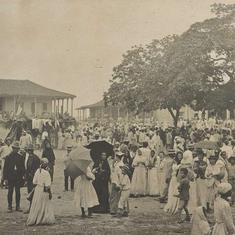From will India play pink-ball cricket, the question has moved to how soon before India plays a day-night Test, and whether it will be at home.
There has long been reluctance on India’s part – as has been the case with any new aspect of internationals, from Twenty20s to Decision Review System – to embrace Test cricket under lights. But if BCCI acting secretary Amitabh Chaudhary is to be believed, it could only a matter of time before India plays with the pink ball.
“I had consulted the Indian team management, the selectors, the office bearers and all were in agreement that one of the two Tests against West Indies will be a day-night Test,” Chaudhary said on the sidelines of the five-day International Cricket Council meet in Kolkata earlier this week. However, there are reports that also suggest that India won’t a play a day-night Test because it is not part of the World Test Championship.
Either way, India playing a Test match under lights at home is not a fanciful idea, rather one that should be tried out sooner than later. Currently, India and Bangladesh are the only two teams that are yet to play a Test match under lights.
When teams played their first Day/Night Tests
| Australia | 2015 |
|---|---|
| New Zealand | 2015 |
| Pakistan | 2016 |
| West Indies | 2016 |
| England | 2017 |
| Sri Lanka | 2017 |
| South Africa | 2017 |
| Zimbabwe | 2017 |
| India | - |
| Bangladesh | - |
Australia has played a day-night Test as part of their home season for the last three years at Adelaide – against New Zealand, South Africa and England – and would definitely want to play one against India this summer. Understandably, India wouldn’t want their first pink-ball experience to be in the tricky conditions at Adelaide and will want to play one at home before.
But one of the major factors working against this is concerns over how the pink ball will behave in Indian conditions, with factors such as flatter pitches, dew factor and reliance on spinners. The Duleep Trophy in 2016-’17 and then in 2017-’18 were played under lights on an experimental basis and the pink ball didn’t get a vote of confidence from most players.
Pink ball concerns
Some of the Indian cricketers The Field spoke to expressed concerns over the pink ball on Indian tracks, which have little assistance for seamers. Another point of interest was the dew factor, which makes it even more difficult. While a few didn’t find it to be an insurmountable challenge, they did maintain that it would be difficult in Indian conditions.
“If the wickets has a bit of grass on it and the outfield is good, the shine on the ball lasts much longer and aids pace. But the rough patches in India will make it very difficult and the dew settling in makes it a little unfair on the bowlers as well,” an Indian cricketer who played with the pink ball in the Duleep Trophy told The Field.

The other problems with the ball, manufactured by Kookaburra at their factory in Melbourne, are the slower wear-and-tear which reduces swing, the visibility of the black seam, and how conducive it for spinners. The spin factor is something that can be worked upon on a turning track, but might not be effective on flatter ones, according to a batsman who played Duleep Trophy.
Shannon Gill, the Head of Communications of Kookburra, addressed these concerns in an interaction with a group of Indian journalists in Melbourne. He said that the structural changes between the pink and red ball are made to ensure visibility under lights.
“Structurally, the pink ball is very similar to the red ball. But for playing cricket at night, you need a light colour ball, lighter than the red ball. But in the course of a cricket match, the ball goes through a lot of wear and tear which dirties it. On a red ball, it doesn’t really matter because it is already a dark colour. But with the pink ball it does,” he said.
Talking about the scrutiny over the pink ball’s seam and swing moment, he conceded that while the nature of the pink ball is different, it isn’t a game-altering factor.

“It is more to do with the fact that there is coating on the ball that it makes it have different characteristics. The seam is not necessarily different, it is the coating on the leather. Generally on a red ball, the lacquer comes off you and you shine it to get it to swing a certain way. With the pink ball, since it has to be visible for 80 overs, it has got a natural shine, so instead of shining the ball it is more about keeping the ball clean for it to start to do things like the red ball,” he added.
History of the pink ball
Gill also explained the background into how the pink ball went from being an idea by the MCC to a regular fixture in international cricket.
“The challenge was set out in 2006 when MCC decreed pink as the colour and Kookaburra were probably the only ball manufacturer to take that seriously. Nine years since that challenge, we had a pink ball used in a Test match for the first time. We tried 16 different shades of pink used before we settled on the final ball,” he explained.
But even after the 2015 Test between the Trans-Tasman rivals, there were a lot of chinks to be ironed, something that they are still working on.
“The original pink ball had a green and white seam like on ODI ball. But one of the criticisms we got was that it was difficult to pick the seam as the contrast was not the same as red. We then switched to a black seam, which gave a better contrast. The feedback since them has been that the seam can be picked better.”
Makes for exciting cricket
Eight day/night Test matches have been played so far, and most of them have been dramatic with results in all. The most recent one saw England dismissed for 58. Does that make it too much of a wildcard?
“Might be luck or coincidence, but most of them have been great matches, six of the eight have been in balance,” Gill said. While this is a great aspect for broadcasters and fans, it is also evident why some cricketers wouldn’t be enthused by the idea of such unpredictability.
Talking about the reluctance of certain batsmen over the seam, Gill gave the example of West Indies’ Darren Bravo who was skeptical about the ball but went on to score a century against Pakistan.
“It’s more a worry from players who have spent most of their professional life picking up one type of colour and seam so to switch is quite a job to the senses. It’s just an adjustment phase, I think,” Gill said.
Top Class! Devendra Bishoo 9 wickets for 49 runs. Career-best with the pink ball in #Dubai pic.twitter.com/XIFTKzNBRc
— CricketWestIndies (@westindies) October 16, 2016
As for the question of spinners, he cites Devendra Bishoo who took a career-best spell of 8-49 that saw Pakistan bundled out for 123, after three days of batsman dominating the pink ball on the UAE pitches. Balanced matches, exciting cricket.
But will the same hold true for India? If it does happen, there will be a host of other topics to address, from stadium administration to broadcast, as discussed in an earlier piece. But for now, it is hard to say, with the see-saw over India’s first day-night Test within the BCCI and the feedback over the ball from the ones who have played it.
Disclosure: This reporter traveled to Australia on a trip sponsored by the Department of Foreign Affairs and Trade.










